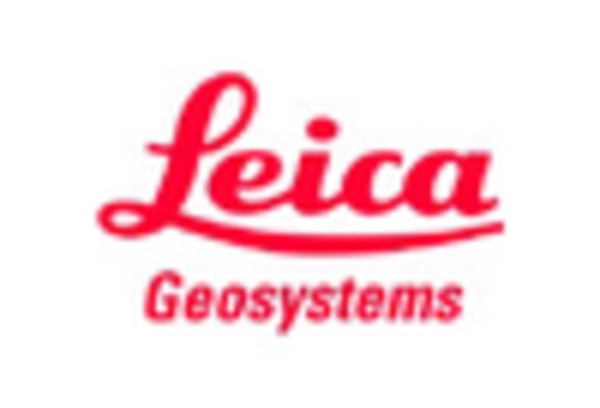Focus on Environmental Compliance
The Terrestrial Laser Scanning Market is increasingly influenced by the growing emphasis on environmental compliance and sustainability. Organizations are under pressure to adhere to regulations that require accurate environmental assessments and monitoring. Terrestrial laser scanning provides a non-invasive method for collecting data on land use, vegetation, and topography, which is essential for environmental impact assessments. The ability to generate high-resolution 3D models facilitates better decision-making regarding land development and conservation efforts. As regulatory frameworks become more stringent, the demand for terrestrial laser scanning solutions is expected to rise. This trend is likely to contribute to a market growth rate of around 12% annually, as companies seek to leverage these technologies to meet compliance requirements and enhance their sustainability initiatives.
Increased Adoption in Various Industries
The Terrestrial Laser Scanning Market is witnessing a surge in adoption across multiple sectors, including architecture, engineering, and construction. This trend is largely attributed to the need for precise measurements and detailed documentation in project planning and execution. For example, the construction industry has increasingly integrated terrestrial laser scanning into workflows to enhance project accuracy and reduce rework. Reports indicate that the market for terrestrial laser scanning in construction alone is expected to reach USD 1.2 billion by 2026. Furthermore, industries such as heritage preservation and urban planning are also recognizing the value of these technologies for capturing detailed site information. As more sectors realize the benefits of terrestrial laser scanning, the market is likely to expand further, driven by diverse applications.
Growing Demand for 3D Modeling and Visualization
The Terrestrial Laser Scanning Market is experiencing a growing demand for 3D modeling and visualization capabilities. As industries increasingly rely on accurate representations of physical spaces, the need for high-quality 3D models has surged. Terrestrial laser scanning provides detailed and precise data that can be transformed into 3D visualizations, aiding in design, analysis, and presentation. This trend is particularly evident in sectors such as architecture and construction, where stakeholders require realistic models for project planning and client presentations. The market for 3D modeling solutions is expected to grow at a rate of 10% annually, driven by the increasing reliance on visual data in decision-making processes. As organizations seek to enhance their project outcomes, the demand for terrestrial laser scanning technologies that support 3D modeling is likely to continue to rise.
Integration with Geographic Information Systems (GIS)
The Terrestrial Laser Scanning Market is benefiting from the integration of laser scanning technologies with Geographic Information Systems (GIS). This synergy allows for the creation of comprehensive spatial data that enhances analysis and visualization capabilities. By combining high-resolution 3D data from terrestrial laser scanners with GIS platforms, organizations can achieve more informed decision-making in urban planning, infrastructure development, and resource management. The market for GIS-integrated terrestrial laser scanning solutions is projected to grow significantly, as more entities recognize the advantages of this integration. It is estimated that the GIS market will reach USD 12 billion by 2027, with a substantial portion attributed to advancements in terrestrial laser scanning technologies. This integration not only improves data accuracy but also streamlines workflows, making it a key driver in the market.
Technological Advancements in Terrestrial Laser Scanning
The Terrestrial Laser Scanning Market is experiencing rapid technological advancements that enhance the precision and efficiency of data collection. Innovations such as improved sensor technology and software integration are enabling more accurate 3D modeling and analysis. For instance, the introduction of high-speed laser scanners has reduced data acquisition time significantly, allowing for real-time processing and analysis. This has led to increased demand across various sectors, including construction, mining, and environmental monitoring. The market is projected to grow at a compound annual growth rate of approximately 15% over the next five years, driven by these technological improvements. As organizations seek to optimize their operations and reduce costs, the adoption of advanced terrestrial laser scanning solutions is likely to become more prevalent.


















Leave a Comment